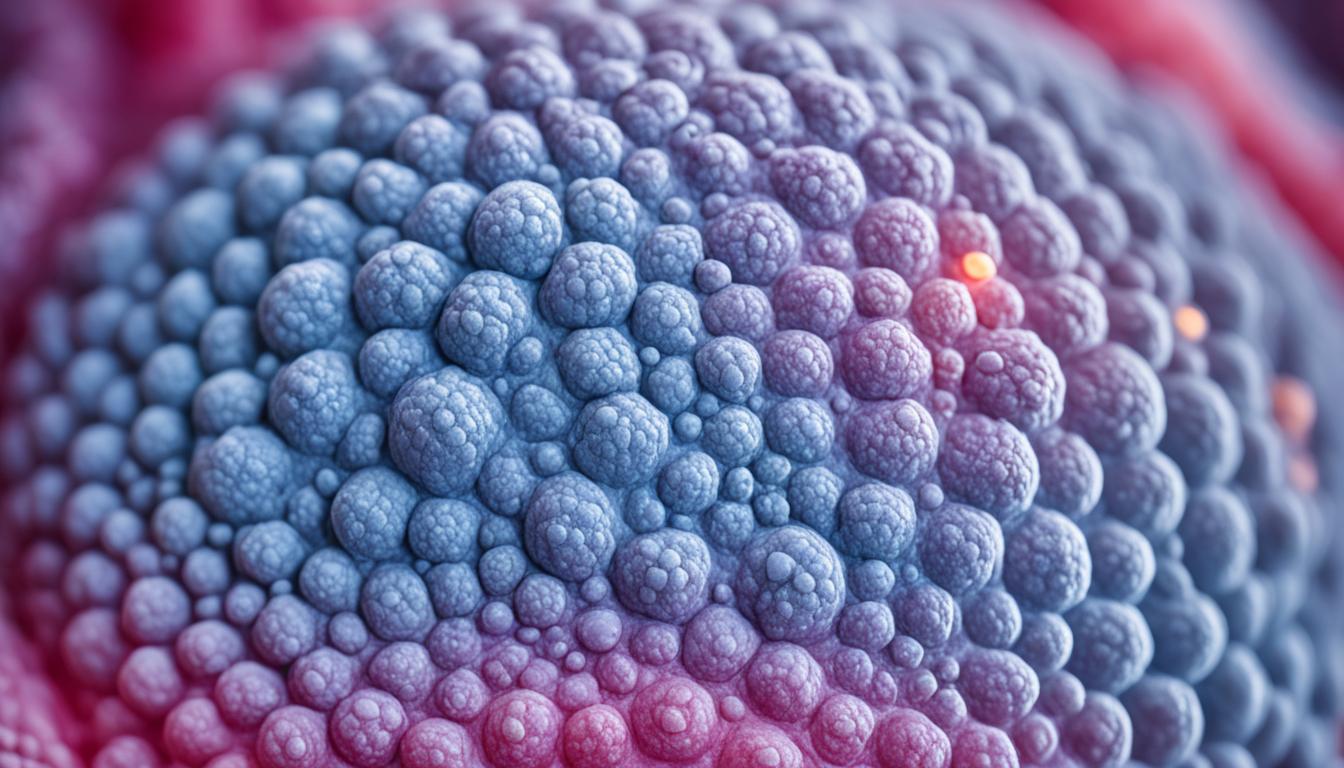Scrotal masses are testicular lumps or swellings in the scrotum. They can happen due to things like cancer, infections, cysts, or if blood vessels are enlarged. This type of cancer is not very common but can impact males a lot. It shows up as painless lumps or swelling. Other signs are pain or a heavy feeling in the scrotum and unequal testicle sizes. Young to middle-aged men around 33 years old are often diagnosed.
Testicular cancer treatment usually starts with surgery to take out the affected testicle(s). Then, patients might have radiation, chemo, or stem cell therapy. Finding it early and treating it fast makes surviving more likely. For many, they can live over 5 years after finding out.
Key Takeaways:
- Scrotal masses are abnormal growths or swellings in the scrotum.
- Testicular cancer is a relatively rare type of cancer that primarily affects males.
- Common symptoms of scrotal masses include painless lumps or swelling in the testicles.
- Treatment for testicular cancer often involves surgery to remove the affected testicle(s).
- Early detection and prompt treatment can significantly improve the prognosis.
Diagnosis and treatment options for scrotal masses
Finding the right diagnosis for scrotal masses is very important. Doctors start by checking the testicles for any odd lumps. They might also do tests like ultrasounds.
Ultrasound imaging looks inside the testicles without any surgery. It shows the size, shape, and what the scrotal mass is like. This helps in making the right diagnosis and plan for treatment.
Blood tests are also key. They check for certain markers that could show testicular cancer. These markers include alpha-fetoprotein, human chorionic gonadotropin, and lactate dehydrogenase. High levels might mean cancer is present. Doctors use this to help pick the best treatment.
Sometimes, a biopsy is needed. This means taking a small piece of the mass to look at under a microscope. It helps confirm if there are cancer cells.
To see if cancer has spread, doctors might use CT scans. These scans check the abdomen, pelvis, and chest. They help see if and where the cancer has spread. This helps with treatment planning.
The treatment for scrotal masses, especially with testicular cancer, depends on factors like the type and stage. Treatments might include:
- Surgical removal takes out one or both testicles. It’s a key first treatment for testicular cancer. The goal is to remove where the cancer started.
- Lymph node surgery is done if the cancer has spread to lymph nodes.
- Radiation therapy uses high-energy X-rays to kill cancer cells. It can be after surgery or as a main treatment.
- Chemotherapy uses drugs to kill cancer. It may be used alone or with other treatments.
- Stem cell therapy aims to make chemotherapy more effective. It replaces the body’s stem cells to reduce side effects. More research is being done here.
The best treatment choice is personal. It’s based on what is best for your health. Sometimes a mix of treatments is used.
After treatment, watch for any return of cancer or new masses. Doctors will suggest regular checks like exams and tests. This is to catch any problems early.
| Treatment Options for Scrotal Masses | Advantages | Disadvantages |
|---|---|---|
| Surgical Removal | – Eliminates primary source of cancer cells – Quick recovery time |
– Permanent loss of affected testicle(s) – Potential psychological impact |
| Lymph Node Surgery | – Removes cancer cells that have spread – May prevent further metastasis |
– Risk of complications – Potential impact on fertility |
| Radiation Therapy | – Targets and kills cancer cells – Non-invasive treatment |
– Potential side effects – Long-term risks |
| Chemotherapy | – Kills cancer cells throughout the body – May shrink tumors before surgery |
– Potential side effects – Impact on fertility |
| Stem Cell Therapy | – Enables higher doses of chemotherapy – Minimizes side effects |
– Emerging treatment – Ongoing research |
Picking the right treatment needs a whole team working together. This includes doctors specializing in different areas. They work to get the best results for people with scrotal masses.
Outlook and prevention of scrotal masses
Getting a diagnosis of scrotal masses, specially testicular cancer, doesn’t mean all is lost. The odds are actually quite good. The chance of living five years after being diagnosed stands at 95%. If the cancer hasn’t spread beyond the testicles, you have a 99% chance of surviving. This drops to 96% if it reaches nearby lymph nodes.
When it spreads to other parts of the body, known as metastasis, the survival rate dips to 73%. But don’t lose hope; finding it early and starting treatment fast makes a big difference.
Preventing testicular cancer involves considering certain risks. While we don’t know why it happens, having a family history or certain testicular issues can increase your chances. Being white is also linked to a higher risk. Unfortunately, we can’t stop it from happening completely. But, doing regular self-exams and seeing a doctor if the scrotum looks or feels different can catch it early. This could mean better chances of overcoming it.

